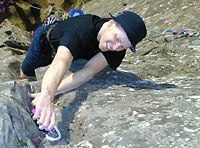Rock climbing
About rock climbing in Iceland
The rock climbing season extends from mid-May to mid-September. The variable weather is the Icelandic rock climber’s main enemy. In addition, the rock here is loose and crumbly in most places and thus the cliffs are often dangerous to climb. Nonetheless, the sport climbing is good with bolted and traditional routes ranging from grade 5.3 to 5.13. The grading system is the same as that used in the US.
The cliffs here are crumbly in most places and there can be loose stones in the cliffs in the climbing areas. When climbing new routes or those not often climbed, it’s a good idea to test your holds before you trust them.

Be respectful and don't leave rubbish behind
Icelandic climbers have always tried to go about their sport in peace, deferring to landowners and the public, and that’s the way we’d like to keep it. If you want to climb on private land, get permission from the owner first. Don’t leave rubbish behind, follow roads and paths where possible to avoid unnecessary erosion, and don’t climb over fences if there’s a gate. In short, be respectful.Don’t put bolts or pegs into cliffs where there are none already: they may be protected natural areas and you will be fined for damaging them.
